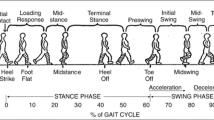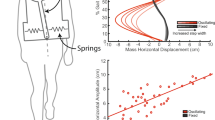Abstract
The suspended-load backpack is found to improve the energy efficiency of walking with a load in some scenarios. The objective of this study is to (i) analyze the dynamic load of the suspended-load backpack over a range of walking speeds and pack masses, and (ii) determine the optimal design parameters for the suspended-load backpack to minimize the effect of dynamic load on the efficiency of walking. A simple spring, damper and mass system is used to model the performance of the suspended-load backpack as well as the typical hiking pack. The oscillating load and phase angle are calculated over a range of loading and spring stiffness values to determine the system resonance and optimal spring stiffness design range for the suspended-load backpack. Our results reveal that the stiffness for the suspended-load backpack should be designed below one half of the resonance stiffness to minimize dynamic loads at a given walking speed. The location and magnitude of the maximum phase angle is also calculated. A performance comparison between the suspended-load backpack and a typical hiking pack demonstrates the beneficial range for the suspended-load backpack. The suspended-load backpack is found to provide significant reductions in the peak backpack load, compared with a typical hiking pack, while carrying large loads at fast walking speeds. The suspended-load backpack performs poorly for low pack loads due to in-phase oscillations between the pack and the walking person.










Similar content being viewed by others
Abbreviations
- A :
-
Oscillating load ratio (scaling factor)
- c :
-
Equivalent pack damping coefficient
- F osc :
-
Oscillating pack force
- F Pack :
-
Total pack force
- g :
-
Gravity
- k :
-
Equivalent pack stiffness
- X, Y:
-
Amplitude of oscillation of person and pack
- m :
-
Total pack mass
- S :
-
Stature (height) of person
- t :
-
Time
- v :
-
Walking speed
- ω :
-
Walking frequency
- ω n :
-
Natural frequency for the pack
- δ :
-
Static deflection of pack
- ϕ :
-
Phase angle
- l 0 :
-
Leg length of person
- \(x, {\dot{x}}, {\ddot{x}}\) :
-
Vertical position, velocity, and acceleration of the torso
- \(y, {\dot{y}}, {\ddot{y}}\) :
-
Vertical position, velocity, and acceleration of the pack
References
Donelan, J.M., Li, Q., Naing, V., Hoffer, J.A., Weber, D.J., Kuo, A.D.: Biomechanical energy harvesting: generating electricity during walking with minimal user effort. Science 319(5864), 807–810 (2008)
Foissac, M., Millet, G., Geyssant, A., Freychat, P., Belli, A.: Characterization of the mechanical properties of backpacks and their influence on the energetic of walking. J. Biomech. 42, 125–130 (2009)
Gard, S.: Comparison of kinematic and kinetic methods for computing the vertical motion of the body center of mass during walking. Hum. Mov. Sci. 22, 597–610 (2004)
Granstrom, J., Feenstra, J., Sodano, H.A., Farinholt, K.: Energy harvesting from a backpack instrumented with piezoelectric shoulder straps. Smart Mater. Struct. 16(5), 1810–1820 (2007)
Grieve, D.W., Gear, R.J.: Relationships between length of stride step frequency time of swing speed of walking for children and adults. Ergonomics 9, 379–399 (1966)
Kinoshita, H.: Effects of different loads and carrying systems on selected biomechanical parameters describing walking gait. Ergonomics 28, 1347–1362 (1985)
Niu, P., Chapman, P., DiBerardino, L., Hsiao-Wecksler, E.: Design and optimization of a biomechanical energy harvesting device. In: 2008 IEEE power electronics specialists conference, Rhodes, Greece, pp. 4062–4069 (2008)
Rao, S.S.: Mechanical Vibrations. Prentice Hall, Singapore (2005)
Roebuck, J.A., Kroemer, K.H.E., Thomson, W.G.: Engineering Anthropometry Methods. Wiley-interscience, New York (1975)
Rome, L., Flynn, L., Yoo, T.D.: Biomechanics: rubber bands reduce the cost of carrying loads. Nature 444, 1023–1024 (2006)
Saunders, J., Inman, V.T., Eberhart, H.D.: The major determinants in normal and pathological gait. J. Bone Jt Surg 35, 543–558 (1953)
Xu, X.: An investigation on the interactivity between suspended-load backpacks and human gait. Graduate dissertation. Faculty of North Carolina State University, Raleigh, NC (2008)
Xu, X., Hsiang, S.M., Mirka, G.A.: The effects of a suspended-load backpack on gait. Gait Posture 29, 151–153 (2009)
Author information
Authors and Affiliations
Corresponding author
Rights and permissions
About this article
Cite this article
Hoover, J., Meguid, S.A. Performance assessment of the suspended-load backpack. Int J Mech Mater Des 7, 111–121 (2011). https://doi.org/10.1007/s10999-011-9153-7
Received:
Accepted:
Published:
Issue Date:
DOI: https://doi.org/10.1007/s10999-011-9153-7




